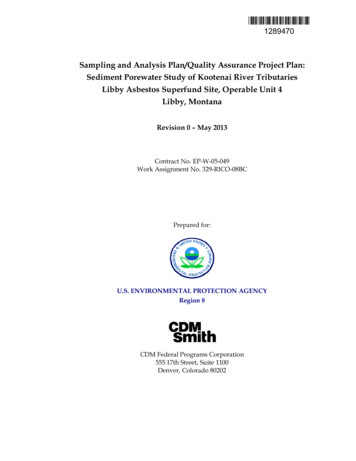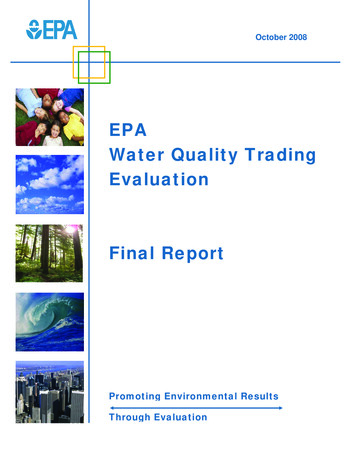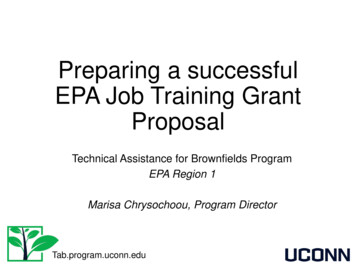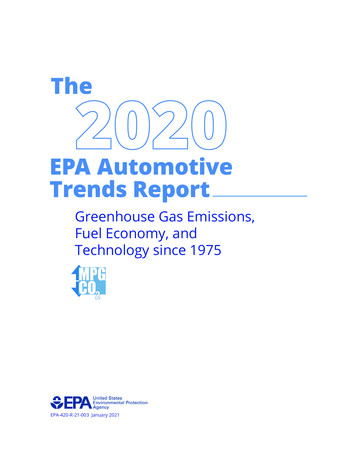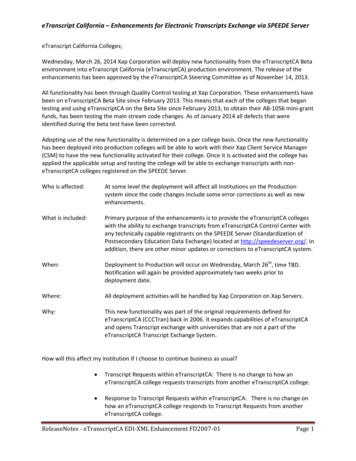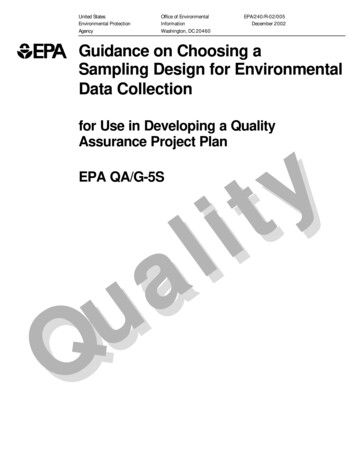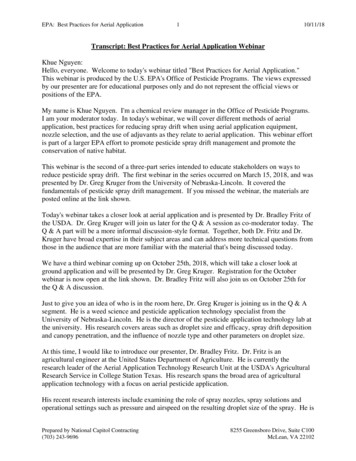
Transcription
EPA: Best Practices for Aerial Application110/11/18Transcript: Best Practices for Aerial Application WebinarKhue Nguyen:Hello, everyone. Welcome to today's webinar titled "Best Practices for Aerial Application."This webinar is produced by the U.S. EPA's Office of Pesticide Programs. The views expressedby our presenter are for educational purposes only and do not represent the official views orpositions of the EPA.My name is Khue Nguyen. I'm a chemical review manager in the Office of Pesticide Programs.I am your moderator today. In today's webinar, we will cover different methods of aerialapplication, best practices for reducing spray drift when using aerial application equipment,nozzle selection, and the use of adjuvants as they relate to aerial application. This webinar effortis part of a larger EPA effort to promote pesticide spray drift management and promote theconservation of native habitat.This webinar is the second of a three-part series intended to educate stakeholders on ways toreduce pesticide spray drift. The first webinar in the series occurred on March 15, 2018, and waspresented by Dr. Greg Kruger from the University of Nebraska-Lincoln. It covered thefundamentals of pesticide spray drift management. If you missed the webinar, the materials areposted online at the link shown.Today's webinar takes a closer look at aerial application and is presented by Dr. Bradley Fritz ofthe USDA. Dr. Greg Kruger will join us later for the Q & A session as co-moderator today. TheQ & A part will be a more informal discussion-style format. Together, both Dr. Fritz and Dr.Kruger have broad expertise in their subject areas and can address more technical questions fromthose in the audience that are more familiar with the material that's being discussed today.We have a third webinar coming up on October 25th, 2018, which will take a closer look atground application and will be presented by Dr. Greg Kruger. Registration for the Octoberwebinar is now open at the link shown. Dr. Bradley Fritz will also join us on October 25th forthe Q & A discussion.Just to give you an idea of who is in the room here, Dr. Greg Kruger is joining us in the Q & Asegment. He is a weed science and pesticide application technology specialist from theUniversity of Nebraska-Lincoln. He is the director of the pesticide application technology lab atthe university. His research covers areas such as droplet size and efficacy, spray drift depositionand canopy penetration, and the influence of nozzle type and other parameters on droplet size.At this time, I would like to introduce our presenter, Dr. Bradley Fritz. Dr. Fritz is anagricultural engineer at the United States Department of Agriculture. He is currently theresearch leader of the Aerial Application Technology Research Unit at the USDA's AgriculturalResearch Service in College Station Texas. His research spans the broad area of agriculturalapplication technology with a focus on aerial pesticide application.His recent research interests include examining the role of spray nozzles, spray solutions andoperational settings such as pressure and airspeed on the resulting droplet size of the spray. He isPrepared by National Capitol Contracting(703) 243-96968255 Greensboro Drive, Suite C100McLean, VA 22102
EPA: Best Practices for Aerial Application210/11/18also interested in exploring the transfer and fate of applied spray under field conditions. Dr. Fritzhas published numerous studies. You can check out his latest research at the link shown on thescreen. Please welcome Dr. Fritz.Bradley Fritz:Thank you, Khue. I also want to say thank you to all the other folks here at EPA that put a lot ofeffort into making this webinar happen. There's a lot of work behind the scenes to makesomething like this come off and happen. So thank you to everybody.Before we get started, I also do a quick disclaimer. Just -- that's part of the role I'm in. I want tosay that the use of trade, firm, or corporation names in this presentation is for the informationand convenience of the viewer. Such use does not constitute the official endorsement orapproval by the USDA, Department of Agriculture, or the Agricultural Research Service, andany other product or service that may be used and suitable is also acceptable.Sorry about that. Before I get into the guts of the presentation, I thought it would be worthspending a little bit of time doing a brief overview of what aerial application looks like in theU.S., sort of a background on the industry just so that those of you online that maybe aren't asfamiliar with the industry have a little bit better appreciation of the size and scope of aerialapplication in the U.S.Across the U.S., we're looking at more than 1,300 aerial application services, and that'scomprised of more than 4,000 individual aircraft. If you go to crop protection products appliedin the U.S. on commercial farms, it's about a quarter of the total application in the U.S.Talking forest protection products, the majority of those products are done aerially. And all thistogether accounts for more than 71 million acres treated aerially. So it's a very large industrycovering a lot of area.A component that we won't really touch on today, but this is something to be aware of, is there'ssome aerial applicators out there that are also working in the public health arena doing controloperations for like insect disease vector such as mosquitoes. And there's also a componentdealing with wildlife and forest fire suppression.If we look at aerial application in the crops that are being covered, based on one of the recentindustry surveys, the five most predominant crops that are covered by the industry -- and again,this is not an inclusive list of everything being done, but is representative of a gross estimateacross the entire industry. It's sort of what you'd expect: Corn, wheat, barley, soybeans,pasturelands, rangelands, and alfalfa. And again, this is going to vary with any region within theU.S. This list may be a little bit different, but you would see this just across the U.S.If we look at the industry as a whole in looking at what the equipment standards are, it's a veryadvanced industry. As it stands now, the majority of the industry, almost 90 percent, is made upof fixed-wing aircraft. Two thirds of those are the faster turbine-based aircraft with about a thirdbeing piston engine aircraft. And then the remaining part of the industry, about 12 percent,would be the rotary or the helicopter platforms.Prepared by National Capitol Contracting(703) 243-96968255 Greensboro Drive, Suite C100McLean, VA 22102
EPA: Best Practices for Aerial Application310/11/18If we look at industry standards in terms of equipment, the current standard in terms of just basic,minimal technologies being used, particularly if we talk about newer aircraft, we're going to beaircraft integrated with GPS systems that help them with their navigation, those have tied theflow control to help them maintain application rate through the field, and then typically usingaerial specific nozzles which have nozzles and check valves and spray systems that are designedexclusively for aircraft.And we're seeing, more and more, some newer technologies come onboard. Some may not befamiliar with the acronym, AIMMS, but there is a system out there that can go onboard theaircraft to do real-time meteorological measurements. And we're starting to see newer spraysystems such as some pulse width modulation systems that offer some unique abilities.If we talk about the average applicator in the U.S., we're looking at an industry that is veryexperienced, with the average applicator having more than 20 years of experience. The guys thatare out there doing this job are not only commercial pilots, but they have to have their applicatorlicense. And both of those mean that they're having to participate in annual training programs.They're doing annual system testing.And it's a very progressive industry in that they're very self-regulating and self-supporting withthe number of training programs and sessions that the industry sponsors that they put on, thatcovers everything from regulatory issues, safety and environmental stewardship, looking at thelatest advances in aerial application technology, and then, you know, concerns such as homelandsecurity and aircraft -- or airfield safety.You'll see throughout this webinar that there's a lot of different technical things that go into thisthat the guys doing this job have to have a fairly broad understanding of topics ranging fromphysics and chemistry to biology, plant physiology, even mathematics and meteorology. So it's avery broad and diverse set of skills that go into doing this kind of work and doing it correctly.So before we jump into some more aerial-specific technologies, it's worth spending a fewminutes on a little bit of background on spray droplet sizing and just understanding the basics,because a lot of what comes out of the basics will be part of the remainder of the topics that we'llcover.So as we get into this, for those of you that may not have any familiarity at all with spray sizes,spray droplets, the scale of measurement that we're talking about is a micrometer. So to give youa perspective of that, bacteria range from about 1 to 10 micrometers, so very, very, very small.When we start talking human hair, we're talking 20 to 180 microns in diameter. Raindrops are,by definition, up to 500 to 4,000 microns. And our agricultural sprays fall somewhere inbetween sort of that raindrop size to the human hair size, typically looking at droplets in thegeneral range of 50 to about 2500 microns.And again, this is not all inclusive of everything. This is just sort of a broad estimate across allthe different spray technologies and chemistries that we're looking at.So droplet diameter is pretty simple. If you were to take that drop, assume it's a sphere. ThePrepared by National Capitol Contracting(703) 243-96968255 Greensboro Drive, Suite C100McLean, VA 22102
EPA: Best Practices for Aerial Application410/11/18diameter is simple, the diameter across the width of that droplet. And then one of the things that-- when we're talking about droplet diameter and spray sizing, the volume contained in thatdroplet becomes important to us because that defines the amount of active material that is beingcarried by the droplet.So in this case, the volume of that droplet is calculated as a relation to the cube of the diameter.And why that's important to us is, if we were to take a droplet that's half that diameter, say halfdiameter D and look at the volume in that droplet, it's 1/8 the volume. And what that means tous is, if we were to take the relationship of the diameter of droplet D and diameter -- diameter ofhalf D and say, how many droplets of half D make up the total volume of the one D diameter,and it takes eight droplets. So breaking one droplet diameter, or diameter D, into half D to getthe same volume, it takes eight droplets.And why that's important is -- let's take one 400-micron drop. And we're going to break that upinto 200-micron drops, but make enough droplets to create the same volume. It takes eight 200micron drops. And if we take that further and break those in half, it takes 64 100-micron drops.So you can see that halving the diameter has a significant impact on the number of droplets.And again, why that's important to us is it really emphasizes that we want to control that dropletsize. Any breakup that we let occur on those droplets starts making significant more numbers ofdroplets, and in particular, more droplets of smaller sizes over which we have less control. Sothat's why we're concerned about droplet size in everything that we do in terms of being able tocontrol where that spray goes.So obviously, sprays aren't made up of a bunch of uniform droplets. Rather, it's a composite of awhole bunch of droplets of different size. And that becomes part of the science of what we do, isunderstanding that total spray volume and how the different droplets of different sizes make upand characterize that spray.So when we talk spray droplet sizing, we're concerned about the total volume of the spray and,further, the total volume of droplets of individual diameters with that spray, again, because we'reconcerned about the amount of active ingredient within each droplet size within that spray.So one of the things that we do is we have some measurements that we use to characterize spray,and then we have some terminologies that we use. And a lot of you are going to be familiar withthese terminologies as you've probably seen them on pesticide labels, likely on extensiondocuments or through research and education seminars or technical talks.And I'm going to refer to one of the standards that we use as part of our work is from theAmerican Society of Agricultural and Biological Engineers, and it's the standard S327, which isterminologies. And one of the most familiar ones, and probably one of the ones that most peopleare familiar with, is this DV0.5 or the Volume Median Diameter, or VMD. And this is the dropletdiameter at which 50 percent of the total spray volume is in droplets of smaller diameter. Andwe'll illustrate in a second.But if I were to tell you that you had a spray that had a VMD of 250 microns, then half of thatPrepared by National Capitol Contracting(703) 243-96968255 Greensboro Drive, Suite C100McLean, VA 22102
EPA: Best Practices for Aerial Application510/11/18spray volume would be made up of droplets of less than 250 microns in diameter.We have two other similar terms, a DV0.1 and DV0.9, and these are very similar in that they'redroplet diameters in which 10 percent and 90 percent respectively of the total spray volume is indroplets of a smaller diameter.And another term we'll introduce here in a second is relative span which relates to these. But ourfirst step is to take a spray, and there's numerous methods out there to evaluate some of thesespray systems and understand what that spray looks like, and to characterize it. But using somesort of measurement system and method, we're going to measure what's going on with the spray.This is just a quick example from one of our setups. This is a 40-degree flat fan at 130-mile anhour with some herbicide mix. And we're using a laser diffraction system in our output like thiswhere we have a cumulative distribution that gives us the different droplet size bins withinmeasurement profile and then the fractional makeup of each of those bins of the total sprayvolume. And then that gives us basically a droplet size curve from which we can extract the datathat we need.So, I introduced relative span. And why that becomes important is it's an indicator -- I call itwidth of the distribution. You might want to call it uniformity of the distribution. But it givesyou an idea of how much variation you have within a given spray cloud.And again, why that becomes at least interesting to us is, if we were to take three different spraydistributions and all with the same potential VMD of 300 microns, we can have one distributionthat had DV10 and DV90 of 200 and 400, and that gives us a relative span of .67. So, you can seewe have a very, very narrowly defined spray characteristics with the majority of our spray in avery, very narrow band of droplet sizes.Take a different distribution, same VMD, but our DV10, maybe we push it out to 165, or DV90,we push it out to 435, and you see our relative span dumps up to 1.4. And maybe on an extremecase, looking at a distribution, again, a VMD of 300, but a DV90 of 90 -- or DV10 of 90 and theDV90 of 510, we had a relative span of 2.2.So, you may see some nozzle manufacture catalogs or you may see droplet sizing data come ontosome guidance or models that give you this relative span number. And again, it's important topay attention to it particularly if maybe all you're given is VMD and relative span.Understanding how that relative span relates to the total shape of the spray is pretty important toyou setting up your system.So, the last thing we'll cover fairly quickly here, in terms of the droplet sizing basics, is probablyone of the more critical factors, and it's this concept of droplet size class. Through the AmericanSociety of Agriculture and Biological Engineers, there's a standard, S572. And for those of youfamiliar with pesticide product labels, that number, S572, is probably familiar because that willbe one of those that tends to be referenced by most of these standards.The standard defines a set of nozzles and spray pressures, each of which is designed to generate aPrepared by National Capitol Contracting(703) 243-96968255 Greensboro Drive, Suite C100McLean, VA 22102
EPA: Best Practices for Aerial Application610/11/18spray -- spray cloud or a spray with droplet sizes of a certain characteristic. And these rangefrom a spray that would be a very fine spray with, you know, very, very small droplets up to aspray that has very, very large, very large diameter droplets, and then a range of other nozzles inthe middle that give you other sprays.And again, for those of us doing the measurements, these become extremely important to whatwe do in our day-to-day research and data collection. The intent of the standards is we take thesenozzles -- so this will be some sample data from some of the work that I've done over the pastseveral years.But we would take each of these nozzles that define these curves. We would run that under ourmeasurement system, and then we would be able to plot these lines that define the classes -- ordefine the boundaries between the classes: very fine, fine, medium, coarse, very coarse, and extracoarse. And so, this essentially is a ruler that defines how these droplet size classes get assignedto any other nozzle, solution, or spray system tested.So, with these reference curves, you would take any other technology that you did a droplet sizemeasurement on. You would plot it relative to these curves, and then you would be able todetermine and assign it a droplet size class. And again, given that we see most labels out thererefer to having to meet some sort of a droplet size class, understanding where this comes from isat least helpful in knowing where the data is coming from and how it's used.So, a quick take-home, you know, understanding that when we half the diameter of a droplet intoequal volume, we get eight times the droplets. Quartering gives us 64. So, the take-home is themore we break up a droplet, the more droplets we make of smaller volume and the less controlyou have over them.A volume distribution is these terminologies that we're dealing with, and these give you theindication of that relative size-- or the classification and the size of the spray relative to the activeingredient being contained within those droplets. And then again, droplet size distribution is thatrelative rating of the spray.So, with that in mind, let's take a look at generally what some of the aerial application nozzleslook like and some of the droplet size trends that we see. This is by no means an inclusivecatalog of pictures of nozzles that are out there and used on aerial systems.But generally, we break these nozzles up into two classes. I like to term them as hydraulicnozzles, and this tends to be flat fan-type nozzles where you have basically a cut at the end of thenozzle that creates this flat sheet. We have straight stream nozzles that are just basically acylindrical nozzle that will gives us a cylindrical spray coming out of the back, and then what Icall an anvil impaction nozzle. So, we'll have something like a straight stream coming out,deflecting against a surface that then deflects that spray and breaks it and spreads it into a sheet.And so, you can see the yellow nozzles over here are those representative of flat fans, straightstreams, and some of the anvil impaction nozzles.Prepared by National Capitol Contracting(703) 243-96968255 Greensboro Drive, Suite C100McLean, VA 22102
EPA: Best Practices for Aerial Application710/11/18Another less commonly used type nozzle, but one that is used by the industry, are rotaryatomizers. These, rather than the actual force of the spray being ejected through the nozzlecreating the breakup, you have liquid basically going into a cage structure that rotates, and thenthat drives the spray liquid radially through a cage, creating the breakup on top of the air shearcoming across it.And there's two classes of these -- you can have some that have their own veins that the airdrives the rotational velocity, or you can actually hook it up to an electrical pump where youhave control over it in the cockpit.So just general trends, if we generally look at across hydraulic nozzles, the most dominant thingabout aerial application, probably the defining characteristic of aerial application is that we havethis extra factor on top of it compared to what you would see in a ground or a boom sprayer.It's actually the fact that we're flying this nozzle through the air, and we're seeing this airstreamthat's basically coming across the nozzle, interacting with the spray, we get this secondarybreakup from that airstream. And that is pretty universally the dominant factor that drives whatwe see in terms of droplet breakup.So just as an example, this is a 40-degree flat fan. And looking at airspeeds from 50 mile anhour up to 180 mile an hour -- and you can see a very dramatic decrease in the VMD as we runthrough those airspeeds. And again, we'll see some more indication of how dominant this airshear/airspeed effect is across these nozzles in a little bit.If we look at spray pressure -- and this is something I'll spend a little bit of time on because thisis something that we see that's unique to aerial systems, and it's something that you'll see later interms of labels that we're challenged with, is that opposite of what we see with the ground orboom sprayer -- and those of you that are familiar with ground boom sprayers, it's fairly wellaccepted and understood that as you increase spray pressure through a nozzle, you decreasedroplet size. And that's true on boom sprayers.When we take these flat fans and straight stream nozzles and put them on an aerial system,what's driving the atomization process is that secondary breakup. And that secondary breakup isa factor that's related to the differential velocity between that spray liquid exiting a nozzle andthe surrounding airstream.So, one of the unique things with aerial systems is, as we increase the spray pressure out of thenozzle, we're actually increasing the velocity of that liquid out of the nozzle. And we'reoffsetting basically the difference between liquid velocity and the airstream velocity, so we'reeffectively decreasing the differential velocity and decreasing atomization.So here are the same nozzles that we looked at in the previous graph. We're increasing spraypressure from 30 psi to 90 psi, and you can see an increase of 50 microns just by increasing spraypressure. So, this is one of the unique things that is, again, unique to aerial systems, and it'ssomething we've been looking at the past couple years as a way of mitigating this increasedbreakup we see at higher airspeeds.Prepared by National Capitol Contracting(703) 243-96968255 Greensboro Drive, Suite C100McLean, VA 22102
EPA: Best Practices for Aerial Application810/11/18Orifice size also has a relationship, and this is one of those that varies by nozzle type. So, if welook at, say, a flat fan nozzle, which is the blue line, we can see that as we increase orifice size,we actually increase droplet size. And I think that's pretty well accepted and pretty common -for those of you that are familiar with ground boom sprayers, we see that same relationship.However, if we look at the straight stream nozzles, we actually see an opposite effect. As weincrease our orifice size, we actually decrease our droplet size, and it's because we're changingthe shape of that. It's actually making for a wider spray volume cross-section, so we're actuallyincreasing breakup out of that nozzle. So, it's just something to consider.And we'll talk a little bit later about some tools that you can use to see some of these trends foryourself and make decisions during your setup.One of the other things we see with aerial systems that potentially gives the pilot some morecontrol over changing the breakup, maybe they're operating at a slower airspeed and want toincrease breakup a little bit, is the ability to deflect the nozzle into the airstream essentiallyincreasing the air shear across the tip and increasing breakup.So again, we look at the same 40-degree flat fan nozzle. As we increase that orientation anglefrom zero degrees, which would be basically horizontal straight back into the airstream, up to 90degrees, which would be perpendicular downward into the airstream, you can see that has a verysignificant effect on VMD -- I mean essentially halving the VMD as we go from zero to 90degrees.A little bit of background on some of these rotary atomizers. They have a little bit differentperformance when we start putting them in the airstream, related to the hydraulic nozzles. In thiscase, I'm looking at the rotary atomizer, and I'm going to keep the blade angle at 55 degrees butincrease the airspeed from 120 mile an hour up to 166.So, one of the things that you would expect that would happen is, as you increase airspeed, yourrotational velocity increases. In this case, we're increasing from 80 rpm -- I'm sorry, from 4,000rpm up to almost 7,000 rpm. And then that has the effect of increasing breakup and decreasingour droplet size. In this case, our VMD goes from about 120 microns down to about 60 microns,so a very significant breakup as we change that rotational velocity.So, one of the unique things about these rotaries is you can actually adjust those blade angles sothat you maintain rotational velocity as you change airspeed.So, in this case, I went through a setup of trying to maintain a rotational velocity fairly close to4,000 rpm. And so, blade angles, then, as we go from 120 degrees to 166, 167 degrees, we'reincreasing blade angle from 55 degrees up to 67 degrees, maintaining that rotational velocity.And then you can see that has the effect of -- we still don't maintain a complete, unchangeddroplet size distribution, but we cut in half the breakup that we get across that range just bymaintaining the rotational velocity. So again, I'll show you some tools later that you can usewhen you're setting up these systems.Prepared by National Capitol Contracting(703) 243-96968255 Greensboro Drive, Suite C100McLean, VA 22102
EPA: Best Practices for Aerial Application910/11/18So, I know this is one of the sections that folks are very interested in. And one of the things Ijust have to do. This is my own disclaimer, my own preface. I'm going to have to say that I amnot a chemist and by no means an expert in adjuvant technologies. What I'm going to present inthe following is really going to be some general types and uses and some of the general trendsthat we've seen over the years as we've worked with and tested these products, particularly as itrelates to spray atomization and what that spray performance out of the nozzle looks like.Having given that disclaimer, and in light of not wanting to leave you out there in the dark withno resources, there are a number of excellent resources out there. But one of the really goodones that I've used over and over is this document put out by Purdue Extension. There is a weblink. Again, you can get this from the handouts.But this Extension document really covers all the different adjuvant types, how they work, whereto use them, why to use them, what they do. I mean, it's an excellent document that is justsomething good to have in your pocket as you're maybe just considering different products touse. This gives you a really good overview and provides a great background.So, I guess, again, like we did with droplet size, let's start with a definition. What is an adjuvant?And for this, I'm going to pull the ASTM standard 1519 that relates to tank mix adjuvants. Andthey defined an adjuvant as "a material added to a tank mix to aid or modify the action of anagrichemical or the physical characteristics of the mixture." So obviously, that's a pretty broadand pretty well catchall description of anything you add to the tank mix.And basically, the intent of that is to do that. And a lot of times we think about adjuvants, and atleast those of us involved in application technology and particularly spray applicationtechnology, the default is maybe to assume that we're putting something in there to change thespray performance. And that's really not the case.More often than not, these adjuvants are added to overcome some other issue, maybe a waterquality issue like hardness or pH, or maybe we're working with a particularly difficult plantspecies or weed species where we need to change the way that spray, once it interacts with thetarget, how its uptake or how it penetrates the surface, or even spray system limitations. Maybewe have something that we just need to correct within our spray system, and even environmentalconditions within the field.So, we've got a couple of these things, I mean, things like pH, maybe, again, some of this finedroplet formation, reducing that, reducing evaporative losses in particularly dry or low-humiditysituations, improving rainfastness, increasing plant uptake, or increasing retention and spread.So, again, this is one of these hard subjects to really catch all because there's literally hundredsand hundreds of different products out there of different types, all of which are designed to dosomething different.So having said that, I want to spend just a few minutes on what we've seen in terms of how someof these adjuvants -- and again, I'm only going to be able to cover, you know, a very, very, verythin slice across t
This webinar effort is part of a larger EPA effort to promote pesticide spray drift management and promote the conservation of native habitat. This webinar is the second of a three-part series intended to educate stakeholders on ways to reduce pesticide spray drift. The first webinar in the series occurred on March 15, 2018, and was

